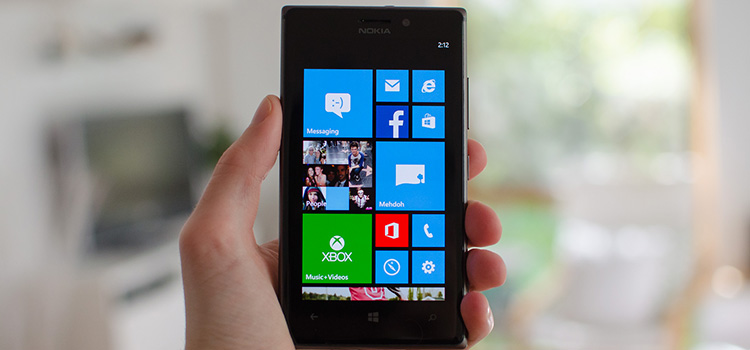Performance
The Nokia Lumia 925 features a tried-and-true Windows Phone chipset: the Qualcomm Snapdragon S4 MSM8960 with a 1.5 GHz dual-core Krait CPU, Adreno 225 GPU and a dual-channel LPDDR2 memory controller. It's not the latest generation of Qualcomm silicon, which has its disadvantages in graphics performance and energy efficiency, but it still performs reasonably well when it comes down to it.
Windows Phone is an operating system that relies heavily on graphics processing to deliver a smooth, 60 frames per second experience and during my time with the 925 I never experienced OS slowdowns despite the underpowered CPU compared to current-gen high-end Android devices. With 1 GB of RAM, multitasking is also reasonably fast, as I only saw the dreaded "Resuming..." screen briefly when reloading applications.
Performing basic tasks in applications is also very fast on the MSM8960, including scrolling lists and panning. I only experienced very minor slowdowns in the camera app when attempting to access the settings, but usually Microsoft's efforts in optimizing the OS have resulted in a smooth, lag-free and quick operating system, especially on Windows Phone's top hardware. High-end phones like the HTC One are probably a small step above the Lumia 925 in terms of app quickness, but by no means is the Lumia 925 a slouch.
In games the Lumia 925 with its Adreno 225 GPU provides necessary grunt to drive 3D rendering on the phone's 1280 x 768 display. The Adreno 225 is currently the fastest GPU you can get on a Windows Phone, so games developed for the platform don't demand resources higher than what you can get on the 925.
I tested a few of the latest games on the Lumia 925, including Halo: Spartan Assault, and found no slowdowns or issues on the performance side. Some of the top-end games aren't of the same caliber as available on Android or iOS, which have devices with more powerful GPUs, but Windows Phone has a decent range and Xbox integration is always a nice feature.
To compare the performance of the Lumia 925 to other smartphones on the market, I ran two benchmarks: WPBench that tests CPU, GPU and memory against other Windows Phones, and Futuremark's Peacekeeper in-browser benchmark.

The Lumia 925 performs as expected, which is exactly the same as other MSM8960 smartphones such as the Lumia 920 and Windows Phone 8X by HTC. It's around 25% faster than the lower-range Windows Phones that use the MSM8227 chipset, and slightly slower than the Lumia 820 which features a lower-resolution display with the same MSM8960 chip as the 925.

Here the Lumia 925 falls well behind other smartphones in browser performance, but it keeps itself in the cluster of other Windows Phones. Faster phones such as the HTC One, Samsung Galaxy S4 i9500 and Apple iPhone 5 gather a score of more than twice that of the 925, and in general browser usage they are faster with less checkerboarding. The scores seen in this benchmark are likely heavily affected by the browser each phone runs, and Internet Explorer 10 on the Lumia 925 isn't the best performer here.
Aside from chipset performance, the connectivity options available on the Lumia 925 and their performance is not of any concern. I had no issues connecting the device to my 5 GHz 802.11n network, while both Blutetooth and A-GPS performance was strong. Mobile network performance was a little weaker than some other devices I tested recently, as data connections tended to drop in low-signal areas where the Galaxy S4 or HTC One wouldn't, but downstream and upstream speeds were both good.
One of the more pressing issues relating to the Lumia 925 is its internal storage. Nokia only put 16 GB into this flagship Windows Phone, which is less than the Lumia 920's 32 GB, and there's no microSD expansion slot. Of the 16 GB, around 13 GB is accessible to the user out of the box, which can quickly fill up once you start loading apps, games, movies and music onto the smartphone.
Update: A 32 GB model is available, but not as widely as the 16 GB model; in some territories it's exclusive to a certain carrier, and in others it's not available at all.
Nokia assumes that the cloud is a perfect substitute for low on-device storage, but many people including myself prefer to conserve mobile data and have large music collections on my device. After loading a small portion of my music collection (around 9 GB) onto the 925, there was just a small fraction left for other data, which is not what you want to see from a phone trying to compete with the Galaxy S4, HTC One and iPhone 5.
While the storage issue is of some concern, overall the performance of the Lumia 925 is excellent thanks to Microsoft and Nokia's efforts into optimizing the OS for a chipset that isn't current generation. Thanks to GPU acceleration every aspect is extremely smooth and fluid to use, and gaming performance is pretty solid as well. It's not quite as fast as some top-end Android devices on the market today, but in everyday usage you probably won't notice.


